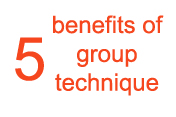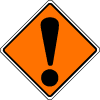Hazard identification
Hazard identification is about determining the hazards that concern people in a given organisation, geographical area, or activity. Hazard identification is a key step in the process of identifying risks and is intended to provide information for further analysis. As we have seen, hazard identification is not straightforward-people may have quite different perceptions on what constitutes a significant hazard. It is therefore important to seek views other than your own.
A group technique for identifying hazards
Hazard identification should be done using a group of people, such as an emergency risk management committee or planning group, with expertise in the area of work, and a commitment to the safety of that area.
* |
'Groupthink' is a phenomenon that can occur in highly cohesive groups - to minimise conflict, the members of the group concur and restrict their thinking to the 'norms' of the group. No one wishes to be seen as 'out of place'. This can very much restrict the range of ideas and views that the group could otherwise generate. |
One quick method to determine people's perceptions of the most serious hazards, and to avoid the pitfalls of 'groupthink', is the following:
When you have finished, the table should look something like the following, where 'hazard A', 'hazard B' etc. mean each hazard that people suggested, and the numbers indicate how many people ranked that hazard as 'high', 'medium', or 'low'.
Table 4.8: Hazard ranking using a group technique
| Hazard | Ranking in terms of 'seriousness' |
||
|
High |
Medium |
Low |
Hazard A |
2 |
3 |
0 |
Hazard B |
0 |
0 |
1 |
Hazard C |
4 |
0 |
1 |
Hazard D |
0 |
2 |
3 |
Hazard E |
0 |
2 |
0 |
Hazard F |
1 |
2 |
0 |
Hazard G |
6 |
0 |
0 |
Hazard H |
0 |
2 |
0 |
Hazard I |
2 |
0 |
0 |
Hazard J |
0 |
3 |
0 |
Hazard K |
0 |
0 |
2 |
Hazard L |
1 |
0 |
0 |
What do the numbers mean? They are an indication of how the people in your planning group feel about the hazards in the area you are studying, and may reflect some accurate knowledge that some people may have. They certainly reflect the group's feeling about which hazards should be addressed. But do not get too concerned about the actual numbers you write down, and certainly do not start adding them up or further manipulating them in any mathematical way.
What is the benefit of this technique?
 |
|
Sixthly , given that you most likely have a limited amount of time in which to study hazards, this technique will indicate the feelings of people as to which hazard/s you should analyse and then later address.
You can use the information from this group technique to either confirm or alter your project scope relating to the hazards chosen for full analysis within your risk assessment.
But the list is just a list-the rankings that the planning group have created do not suggest that one hazard is more likely to occur than another, or that one hazard will affect a larger area than another, or that one hazard may do more harm than another.
This information you will be able to determine later in the hazard analysis process.
Other techniques for identifying hazards
Once you have gained the opinions of your planning group, you can begin to use other techniques to identify hazards.
|
Further group work The following questions for group discussion are the beginning of these techniques:
|
Seeking direct evidence
Finally, you need to have a good look around your organisation, community or geographical area, to see what is there. It is surprising the number of potential problems you can find if you look for them, although not all of them may be serious problems when analysed.
Assignment work
Your first assignment is very close to being due. Check your Subject Outline for the due date. By now you should have all of the information at hand to complete your first assignment (Project Definition). Most of the information has already been placed into a draft document. Now you need to review that draft, reflect on its content compared to the information required, fine tune it and produce the final version for the first assignment. Of course, feedback from the first assignment marker and ongoing planning group discussions will likely require some aspects of the Project definition to be fine tuned or altered before inclusion in the Final Project Report (assignment 2). This is only natural and need not cause you to worry or be concerned.
You will also need to prepare for your ongoing planning group meetings. How many you have really depends upon the availability of planning group members and the tasks that need to be undertaken. However you should use these meetings to keep the planning group abreast of the project's progress. You first planning group meeting should:
- confirm or alter your project definition;
- identify hazards in your area of study;
- select the priority hazards for further analysis to present as your major assignment (based on which hazards the planning group believe are the most significant using the political, social and economic impact filter);
- begin describing those hazards.


